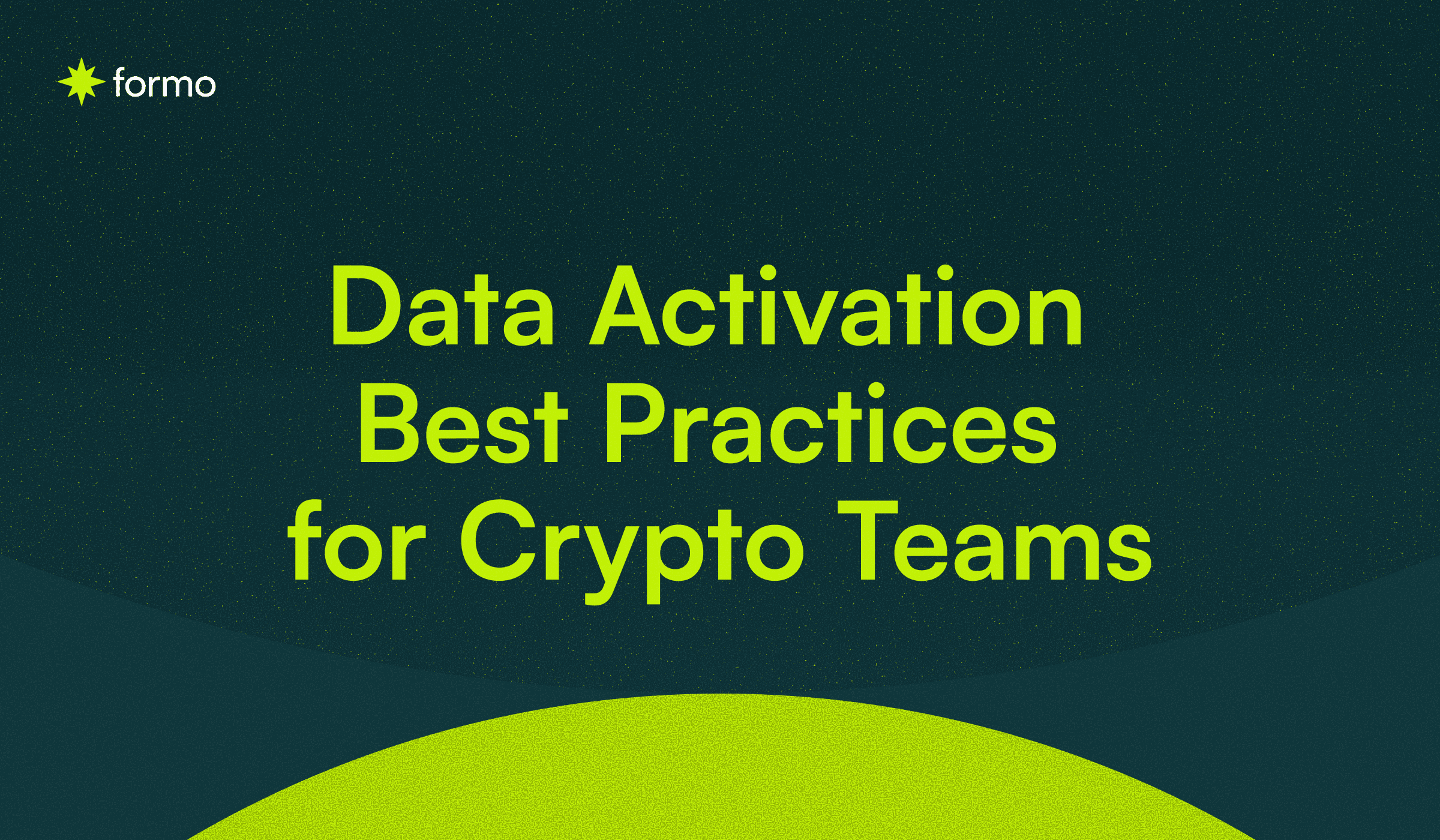For Web2 marketers, perfecting audience targeting became a science. For Web3 teams, the anonymous nature of the space can make user acquisition feel like wandering in a dark forest. You might be moving, but the path forward is unclear. How do you find your next high-value user when everyone is just a string of characters?
The answer lies in translating a proven Web2 concept into the onchain world: lookalike audiences. Instead of relying on personal data and cookies, Web3 lookalike audiences are built using onchain data and wallet intelligence. By analyzing on-chain behavior—like transaction history, token holdings, and protocol interactions—you can find new, high-value users who mirror your best customers.
In today's competitive Web3 landscape, spray-and-pray marketing is no longer a viable strategy. It’s expensive, inefficient, and fails to attract the right customers. Precise targeting through Web3 lookalike audiences isn't just a "nice-to-have"; it's a core driver for sustainable growth, efficient user acquisition, and long-term retention.
This guide will cover what Web3 audiences are, why they are essential for growth, the challenges in building them, and their practical applications.
What Are Web3 Lookalike Audiences?
To understand Web3 lookalike audiences, let's quickly recap the Web2 model. Platforms like Meta and Klaviyo build lookalike audiences by analyzing user data such as demographics, interests, and online behavior. They find new people who share similar characteristics with your existing customers.
The Web3 paradigm shifts this model from personal data to on-chain behavior. Here, the "user" is a wallet address, and wallet intelligence is the key to understanding them. It involves analyzing a rich tapestry of on-chain data points:
DeFi Activity: Which protocols do they use? Are they a DeFi degen or retail user? Are they into fixed yield or perpetuals?
Token / NFT Holdings: What communities are they part of? What does their collection say about their interests?
Transaction frequency
Onchain attestations
A Web3 lookalike audience is a group of new wallet addresses that exhibit similar on-chain behaviors and characteristics to your existing high-value users. These could be your top traders, most loyal liquidity providers, or most engaged community members. By unifying insights from on-chain data (transactions, wallets) and off-chain data (session analytics, marketing intelligence, campaign touchpoints), you can move beyond surface-level targeting and build a precise, data-driven growth strategy.
Why Lookalike Audiences Are a Growth Engine for Web3
Leveraging deep wallet intelligence to build lookalike audiences provides a powerful engine for sustainable growth. It allows dApps to gain granular insights into wallet behaviors, understand user preferences, and adapt their strategies to meet community needs effectively.
Here’s why this approach is so transformative:
Precision Targeting Powered by Wallet Intelligence: Instead of casting a wide, expensive net, you can focus your efforts on users who closely match your best customers. Analyzing wallet behaviors like token holdings, transaction history, and dApp usage allows for precise segmentation and targeting.
Reduce Customer Acquisition Cost (CAC): Marketing spend and token incentives is directed at wallet addresses most likely to convert, based on historical behavioral patterns—not guesswork. This focus dramatically lowers CAC by eliminating wasted resources on uninterested audiences.
Higher Quality User Acquisition: Attract users who resemble your "whales" or power users. These users are more likely to have a higher lifetime value (LTV), engage deeply with your protocol, and contribute positively to the community.
Stronger Community & Network Effects: By identifying and attracting users already active in adjacent ecosystems (e.g., users of a complementary DeFi protocol), you can build a stronger, more interconnected community and amplify network effects.
Smart User Segmentation: Grouping users by transaction volume, activity level, or protocol interactions allows you to create custom campaigns and product experiences that drive action. This targeted approach boosts engagement and fosters loyalty.
The Hurdles: Challenges in Building Actionable Web3 Audiences
While the potential of Web3 lookalike audiences is immense, building them is not without challenges. Many teams struggle to overcome several key hurdles that prevent them from unlocking actionable crypto audience intelligence.
Data Fragmentation: User data is scattered across multiple blockchains (Ethereum, Polygon, Solana), dApps, and wallets. Creating a unified view of a user's activity is a significant challenge, a pain point frequently mentioned in discovery calls with Web3 teams.
The Pseudonymity Problem: A single user often operates multiple wallets, making it difficult to form a complete profile. The technical process of linking these wallets, known as wallet clustering, is complex but crucial for accurate audience building.
Onchain-to-Offchain Attribution: Connecting a user's on-chain actions (like a token swap) to their off-chain journey (like clicking a Twitter ad) is notoriously difficult. Tools like Dune are powerful for analysis but are often manual and not designed for real-time attribution, leaving marketing teams unable to measure ROI accurately.
Data "Noise": The on-chain world is filled with noise from bot-driven "sybil" attacks and wash trading. Differentiating genuine user activity from this noise requires sophisticated crypto audience intelligence to ensure you are targeting real, high-intent users.
The Building Blocks of Web3 Audience Intelligence
To overcome these challenges, a robust Web3 audience intelligence platform needs several foundational components. These building blocks work together to transform raw, fragmented data into clear, actionable insights.
Unified Data Insights: The first step is to use product analytics that can combine on-chain and off-chain data. This creates a 360° view of the user journey, from the first marketing touchpoint to their on-chain conversion, providing complete visibility for data-driven decisions.
Wallet Analytics: Accurately grouping wallets that belong to the same entity is essential. This is achieved by analyzing funding patterns (e.g., wallets funded from the same exchange account) and shared on-chain interactions, ensuring precise user profiling.
Cross-Chain & Social Linkage: A user's identity isn't confined to a single blockchain. Mapping their activity across multiple chains and integrating off-chain social signals from platforms like Farcaster or Lens provides a holistic view of their Web3 identity.
Advanced Behavioral Analytics: True understanding goes beyond simple token holdings. It requires analyzing complex patterns like transaction frequency and value, governance participation, and unique habits like NFT minting versus trading. This allows for deeper segmentation based on what users do, not just what they own.
Onchain User Segmentation: With a rich dataset, you can categorize wallets by roles (e.g., "DeFi Power User," "Perps Trader", "Passive Yield"), activities, transaction volume, and engagement level. This powers precision campaigns and tailored web3 growth initiatives.
By analyzing wallet properties, on-chain behaviors, and social signals you can reach new users who behave just like your top, most valuable users.
Practical Applications: Putting Lookalike Audiences to Work
Once you can build Web3 lookalike audiences, you can deploy them across your growth, product, and marketing strategies. Here are some ideas:
Hyper-Targeted Growth Campaigns: A new perpetuals DEX, for instance, could build a lookalike audience based on the most active traders from established platforms like GMX and dYdX. This allows them to run a targeted airdrop or incentives program that directly reaches high-potential users.
Proactive Retention Strategies: By identifying wallets that resemble recently churned users (e.g., they've stopped staking or their transaction frequency has dropped), you can proactively reach out. A targeted offer, like a special APY boost or an announcement about a new feature, can re-engage them before they leave for good.
Smarter Airdrop Distribution: Instead of a "spray-and-pray" airdrop that attracts bots and airdrop farmers, you can target a lookalike audience of "genuine DeFi users"—those who have participated in governance on other protocols. This filters out sybil attackers and ensures your tokens land in the hands of valuable community members.
Personalized Experiences: Imagine a Web3 gaming platform offering a special NFT weapon to new users whose wallets resemble those of top players. This personalizes the onboarding experience from the very first interaction, increasing engagement and retention.
Privacy for Web3 Lookalike Audiences
The power of lookalike targeting brings with it a responsibility to uphold the core ethos of Web3: user privacy and pseudonymity. It's crucial to walk the fine line between effective targeting and invasive surveillance.
Best practices include:
Respect Pseudonymity: Focus on analyzing behavioral cohorts, not deanonymizing individuals. The goal is to understand patterns, not to uncover personal identities.
Transparency: Be open with your community about how you are using on-chain data for targeting. Clear communication builds trust.
Opt-In Mechanisms: For more direct engagement, such as wallet-to-wallet messaging, always implement opt-in systems to prevent spam.
Avoid Over-Profiling: Ensure your crypto audience insights are used to enhance the user experience, not to stalk or exploit users.
The Future of Onchain Growth
Web3 lookalike audiences, powered by deep wallet intelligence, represent the next frontier for sustainable growth. They transform marketing from a cost center into a precise, high-ROI growth engine. The era of simply building a great product and hoping users will come is over. For any serious Web3 team, understanding and intelligently targeting your audience is now a fundamental requirement for success.
Start thinking about your own high-value users. Who are they, and what do they do on-chain? Answering these questions is the first step toward building a powerful growth machine.
Follow Formo on LinkedIn and Twitter, and join our community for more onchain growth insights.
Next steps
Many Web3 teams find themselves stuck with manual queries on tools like Dune. While powerful, these dashboards are often static and don't provide the real-time, actionable web3 user analytics needed to drive growth effectively.
This is where a platform like Formo comes in. Formo is designed to solve these pain points by unifying onchain and offchain data to provide real-time audience intelligence. Key capabilities include:
Real-Time Segmentation: Instantly create and analyze audience segments without writing complex SQL queries.
Automated Wallet Intelligence: Formo automatically profiles wallets, identifying DeFi traders, NFT collectors, and more, which can be used to build a seed audience for your lookalike models.
End-to-End Attribution: Finally connect your marketing campaign touchpoints to onchain conversions, allowing you to measure true ROI and optimize your spend.
By moving beyond static dashboards to an active intelligence platform, Formo helps teams can turn data into decisions and drive meaningful growth. Sign up for free.
Frequently Asked Questions (FAQs)
What is the difference between Web2 and Web3 lookalike audiences?
Web2 lookalike audiences are built using personal data like demographics, interests, and browsing history. Web3 lookalike audiences are created using pseudonymous on-chain data, such as transaction history, dApp interactions, and token holdings, focusing on behavior rather than personal identity.
How does wallet intelligence help improve user acquisition in crypto?
Wallet intelligence provides deep insights into a user's on-chain behavior, allowing you to identify what your best users have in common. This enables you to find and target new users who exhibit similar patterns, resulting in higher-quality acquisitions and a lower customer acquisition cost (CAC).
What on-chain data is most important for building a crypto lookalike audience?
Key data points include transaction history (frequency, value, tokens traded), dApp interactions (protocols used), NFT holdings (collections, minting vs. trading behavior), and DeFi activity (staking, liquidity providing, governance voting).
Can I use lookalike audiences to prevent sybil attacks during an airdrop?
Yes. By building a lookalike audience based on "genuine" users (e.g., those with a long transaction history or governance participation), you can filter out newly created wallets and bot-like activity, making your airdrop distribution more effective and resistant to sybil attacks.
How does Formo ensure user privacy while providing deep web3 audience analytics?
Formo is built with a privacy-first approach. We focus on analyzing behavioral patterns of pseudonymous wallet addresses, not on deanonymizing individuals. Our platform avoids invasive tracking methods like third-party cookies or device fingerprinting, aligning with the core privacy principles of Web3.
Do I need to be a data scientist to use Web3 audience intelligence tools?
No. Modern platforms like Formo are designed with user-friendly interfaces that allow product and marketing teams to create segments, analyze data, and build audiences without needing to write SQL or have a deep background in data science. Audience intelligence makes onchain data accessible for non-technical teams!
What are the first steps to creating a lookalike audience for my DeFi protocol?
First, identify your "seed audience"—a group of your best existing users (e.g., top liquidity providers or most active traders). Second, analyze their shared on-chain behaviors to define their profile. Finally, use an audience intelligence tool to find new wallets that match this profile.
How is audience intelligence different from standard Web3 analytics?
Standard Web3 analytics often focus on protocol-level metrics like Total Value Locked (TVL) or transaction volume. Crypto audience intelligence goes deeper by focusing on the user behind the wallet, analyzing behavioral patterns, segmenting audiences, and enabling targeted action to drive growth and retention.





